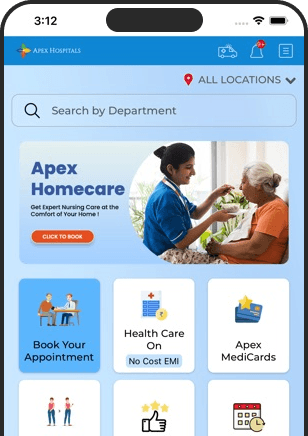Understanding Good Cholesterol vs Bad Cholesterol – And How to Manage Both
By:

Apex Hospitals
11-04-2025

When people hear the word "cholesterol," it often sparks concern. It's long been associated with heart attacks, clogged arteries, and poor health. But what many don’t realize is that cholesterol isn’t the villain it’s made out to be, at least, not entirely. Your body needs cholesterol to function properly.
Cholesterol is a waxy, fat-like substance found in your blood. It plays a crucial role in building cell membranes, producing hormones, supporting digestion, and even helping your body absorb vitamin D. Most of the cholesterol your body needs is made by the liver, but we also get it from foods, especially meat, dairy, and other animal-based products.
However, problems arise when cholesterol levels go beyond what your body needs. Too much cholesterol can lead to plaque buildup in your arteries, a condition known as atherosclerosis. This can narrow the arteries and restrict blood flow, raising the risk of heart attacks, strokes, and blood clots.
So, what matters is the type of cholesterol circulating in your body, and finding the right balance between the good and the bad.
Maintaining healthy cholesterol levels is crucial for protecting your heart and blood vessels. While your liver naturally produces the cholesterol you need, lifestyle habits, especially your diet, can push those levels out of balance.
Eating a diet high in saturated fats, being physically inactive, smoking, and having certain medical conditions (like diabetes or thyroid disorders) can cause your LDL to rise and your HDL to fall. Over time, this imbalance can silently damage your arteries and increase your risk of life-threatening complications.
What are the different types of cholesterol?
Your body uses two main types of lipoproteins to carry cholesterol through your bloodstream, LDL and HDL, each playing a different role in your health.
- LDL (Low-Density Lipoprotein) is often called the “bad” cholesterol. It carries cholesterol to your arteries, and when there’s too much of it, it can stick to the walls of your blood vessels. This buildup, known as plaque, narrows the arteries over time and raises the risk of heart disease and stroke.
- HDL (High-Density Lipoprotein) is considered the “good” cholesterol. It works like a cleanup crew, picking up excess cholesterol from your blood and transporting it back to the liver. From there, your body gets rid of it. Higher levels of HDL are associated with a lower risk of heart-related issues.
When LDL cholesterol levels are too high and HDL levels are too low, it creates a dangerous imbalance that puts extra strain on your heart and circulation.
Now, let’s talk about triglycerides, another important part of your cholesterol profile. Triglycerides are a type of fat found in your blood that your body uses for energy. However, when levels get too high, especially when combined with high LDL or low HDL, your risk for heart attack and other cardiovascular problems increases significantly.
Know the numbers
High cholesterol is often called a “silent” problem because it doesn’t come with obvious warning signs. Most people don’t realize their levels are elevated until they’ve had a simple blood test, usually part of a routine check-up. The test reports your cholesterol in milligrams per deciliter of blood (mg/dL) and gives you several key numbers to watch:
Triglycerides
- A common form of blood fat.
- Aim for below 150 mg/dL (exact targets can vary slightly by lab).
- High triglycerides combined with high LDL or low HDL raise your risk of atherosclerosis.
HDL (High-Density Lipoprotein) – the “good” cholesterol
- Higher is better because HDL helps remove excess cholesterol.
- Targets: over 50 mg/dL for women and over 40 mg/dL for men.
LDL (Low-Density Lipoprotein) – the “bad” cholesterol
- Lower is better; excess LDL sticks to artery walls and forms plaque.
- If you have no history of heart or vascular disease or diabetes, keep LDL under 130 mg/dL.
- If you do have these conditions—or your doctor feels you’re high-risk—aim for under 100 mg/dL (or even under 55
mg/dL in very high-risk cases).
Total Cholesterol
- A combined figure that includes HDL, LDL, and 20 % of your triglyceride value.
- “Normal” ranges differ slightly between laboratories, so follow the reference range on your report.
Because you can’t feel high cholesterol, scheduling regular blood tests is the only reliable way to know your numbers and to take action before problems arise.
How to Manage Your Cholesterol Naturally
You don’t always need medication to control your cholesterol. Here are simple, proven lifestyle changes that can help balance your cholesterol levels:
Eat Heart-Healthy Foods
1. Increase intake of fruits, vegetables, whole grains, and legumes
2. Choose healthy fats: olive oil, avocados, and nuts
3. Avoid trans fats and saturated fats found in processed and fried foods
4. Eat fatty fish at least twice a week
Stay Active
1. Aim for at least 30 minutes of moderate exercise, 5 times a week
2. Walking, cycling, swimming, and yoga are great options
Maintain a Healthy Weight
Losing even a few kilos can significantly improve your cholesterol levels
Quit Smoking & Limit Alcohol
1. Quitting smoking raises your HDL
2. Too much alcohol can increase triglycerides, moderation is key
When to Seek Medical Help
If lifestyle changes alone aren’t enough, your doctor may prescribe statins or other cholesterol-lowering medications. Regular follow-ups are essential to adjust your treatment plan and ensure you're on the right path.
At Apex Hospitals, we offer comprehensive cardiac check-ups and personalized cholesterol management plans to keep your heart strong and healthy.
Understanding the difference between good and bad cholesterol is the first step toward a heart-healthy life. By making informed choices and embracing healthy habits, you can take control of your cholesterol and protect your heart for years to come.
Take care of your heart, one step at a time. Your body will thank you for it.
FAQS
Related Articles
Connect With Us
Health In A Snap, Just One App.
KNOW MORE



































































































